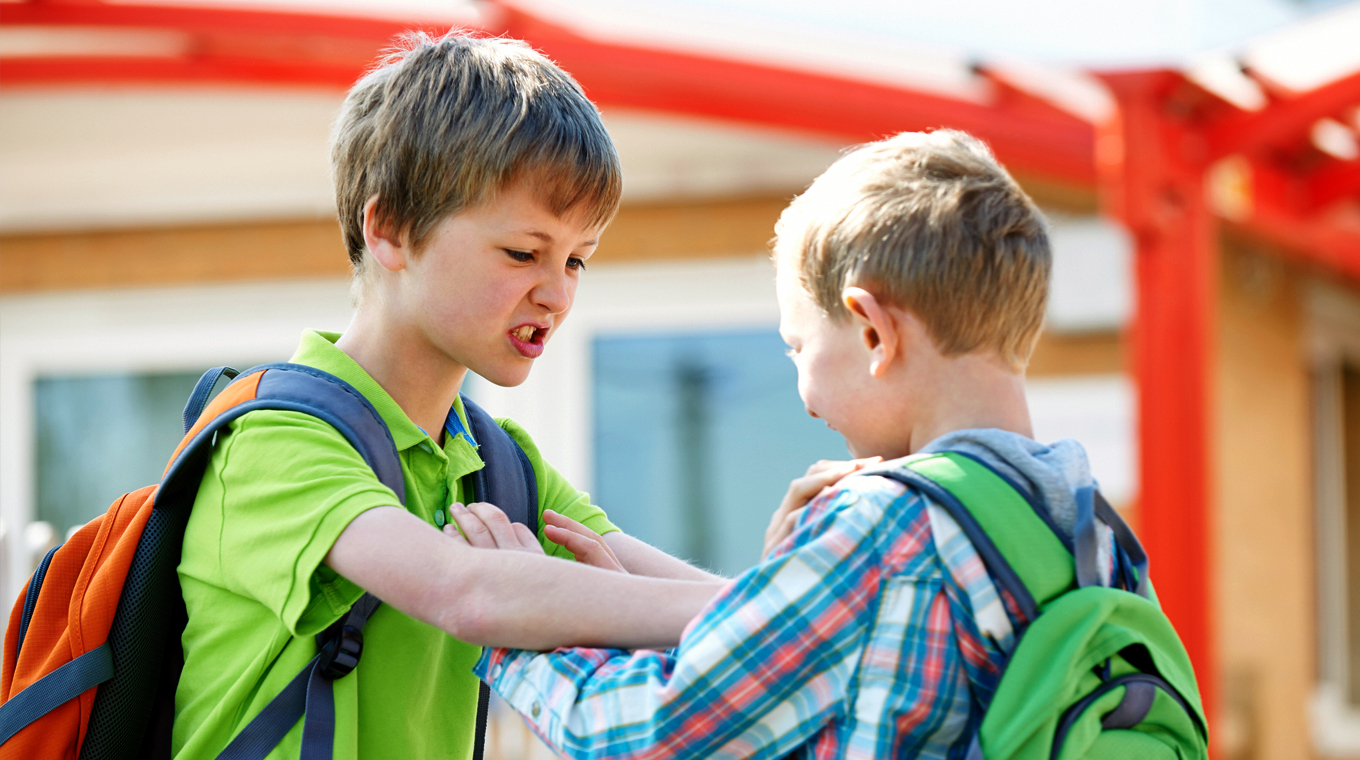In this article
October is National Bullying Prevention Month, a month-long initiative aimed at inclusivity, empathy, kindness, and acceptance in an effort to raise awareness about recognizing bullying behavior and preventing childhood bullying. If you’ve noticed questionable behavior from your own child or want to broach the subject of how not to be a bully, here are some ideas to help open the lines of communication.
Why do people bully?

Bullying is defined as aggressive behavior toward others that occurs as a result of a power imbalance, either actual or perceived. Children dealing with stressful situations like the death of a family member, divorce, or other changes in the family, can exhibit bullying behavior as focusing their attention on someone else — via bullying — allows them to momentarily forget what’s the stressors in their own lives.
If your child has a lack of empathy for others, refuses to admit they’re wrong when called out for treating others disrespectfully, or if they’ve been a victim of bullying themselves, you may need to do some further digging.
Talk to your child’s teacher, caregivers, and friends’ parents if you have suspicions or wish to get someone else’s take on any troubling behaviors your child exhibits. Sometimes that outside input can help you determine whether you need to address your child’s behavior or ease your mind if you’re overreacting.
How to teach bullying is bad

The best way for caregivers to teach bullying is bad is by modeling respect for others and talking to kids about how people should be treated. When confronted with a situation in which someone is being bullied, whether it’s wait staff at a restaurant or a cashier at the grocery store, speak up on that person’s behalf. Your child will take notice. Modeling what is acceptable behavior and doing the right thing will teach bullying is not to be tolerated.
And that goes for how you treat them, too. “You can’t belittle, embarrass, or call your child names then hold them to a different standard,” Oklahoma mom of two Meredith Garret wrote on her blog “And if you do subscribe to that mentality, please consider your role in perpetuating this toxic cycle, for they may not say it to you, but they’ll certainly spew it to someone else.”
How to not raise a bully in your home
Providing words of affirmation and allowing your child the freedom to occasionally make choices and decisions for themselves and the family, is a great way to build their confidence. If your child is able to take lead at times, they’ll gain a sense of control over what’s happening in their lives. Ask your child their opinion on current events.
Allow them the opportunity to make suggestions, like where to go out for dinner or choosing the next family vacation destination. Recognizing and asking for your child’s input will help them feel heard, and that what they say matters and is important.
This connection creates a foundation of respect and will go a long way toward raising a child who is empathetic, thoughtful, and kind. This type of connection at home provides your child with the tools and resources needed to foster healthy relationships outside of the home.
How to prevent cyberbullying

Cyberbullying — bullying that occurs via social media, text, or social media apps — is a growing problem in the United States. In fact, almost 15% of high school students say they’ve been bullied via electronic devices in the prior 12 months. This type of bullying shows up via social media posts, comments within gaming apps, hate groups, and text.
“Bullying now is almost synonymous with cyberbullying,” Dr. Mike Franz, Blue Cross behavioral health medical director told Portland’s KGW8. “Traditional bullying can still occur, but with the advent of social media and smartphones, unfortunately, we’re seeing about 20% of students experiencing cyberbullying in any given year.”
If you think your child may be the bully, know that parents are taking the issue seriously. They are advised to consistently document any instances of bullying, make copies of all documents and reports related to the incidents, and file complaints if necessary, with the school board or department of education. So, it’s important to address any issues right away if you suspect your child is bullying others.
“As parents, we need to be aware this is happening. We need to notice. If we have any concern at all, we need to approach our child and have open-ended questions in a safe environment and probably even before that, be aware of how much social media access they have,” Franz advised.
If your child is a bully, know that there may be serious repercussions from the kids they victimize. In 2013, the Anti-Bullying Act was signed into law requiring all primary and secondary schools in the United States to adopt an anti-bullying policy. However, since schools often fall short when it comes to resolving bullying-related issues, parents of bullied kids are reaching out to law enforcement and attorneys to ensure their child’s safety.
If you wonder whether or not your child is a victim of cyberbullying, take note of their behavior. If they seem to withdraw or not use their devices for long periods of time or lash out or get emotional after having used their device, they could be facing experiencing cyberbullying, especially if those behaviors coincide with changes in grades, behavior, trying to get out of going to school and avoiding friends.
Help your child avoid being the victim of cyberbullying by reminding them not to overshare or give out personal information online. Often young people don’t recognize the permanency of the internet, so it’s important that they know that what they post online, stays forever.
Make sure your child knows how to turn off location-sharing, log out when using a public computer or other devices, use privacy tools and settings, and protect their accounts with security measures. Content monitoring services are another avenue caregivers can take to enable them access to what their children are doing and seeing online.





